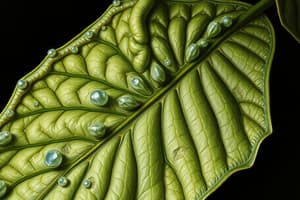Podcast
Questions and Answers
What type of meristem is responsible for the increase in girth of the stem?
What type of meristem is responsible for the increase in girth of the stem?
- Apical Meristem
- Lateral Meristem (correct)
- Vertical Meristem
- Intercalary Meristem
Which of the following statements about plant and animal tissues is incorrect?
Which of the following statements about plant and animal tissues is incorrect?
- Some tissues in plants divide throughout the life
- There is no demarcation of dividing and non-dividing regions in animals
- Cell growth in animals is more uniform as compared to plants
- Animals have more dead tissues as compared to plants (correct)
The length of the stem increases mainly due to which type of meristem?
The length of the stem increases mainly due to which type of meristem?
- Vertical Meristem
- Intercalary Meristem
- Apical Meristem (correct)
- Lateral Meristem
Which of the following features does NOT describe cells of Meristimatic tissue?
Which of the following features does NOT describe cells of Meristimatic tissue?
Which meristem type is associated with the lengthening of internodes and leaf bases?
Which meristem type is associated with the lengthening of internodes and leaf bases?
Which type of plant tissue is primarily responsible for flexibility?
Which type of plant tissue is primarily responsible for flexibility?
Which function is not associated with the epidermis of a plant?
Which function is not associated with the epidermis of a plant?
Which of the following parts does not contain cartilage?
Which of the following parts does not contain cartilage?
Which types of muscles are classified as involuntary?
Which types of muscles are classified as involuntary?
Which element of xylem tissue facilitates lateral conduction of water?
Which element of xylem tissue facilitates lateral conduction of water?
In which tissue are fats primarily stored in the human body?
In which tissue are fats primarily stored in the human body?
How are the components of a neuron typically labeled in a diagram indicating A, B, C, and D?
How are the components of a neuron typically labeled in a diagram indicating A, B, C, and D?
In a diagram of connective tissue, which of the following parts are correctly labeled?
In a diagram of connective tissue, which of the following parts are correctly labeled?
Flashcards are hidden until you start studying
Study Notes
Tissues
- Tissues are groups of similar cells that work together to perform a specific function.
- Plants and animals both have a variety of tissues.
Plant Tissues
- Meristematic Tissue: Actively dividing cells with thin cell walls, dense cytoplasm and no vacuoles. Responsible for growth in plants.
- Apical Meristem: Found at the tips of roots and stems, responsible for increase in length.
- Lateral Meristem: Found in the cambium layer and responsible for increase in girth.
- Intercalary Meristem: Found at the base of leaves and internodes, responsible for increasing the length of internodes.
- Permanent Tissue: Cells that have stopped dividing and are specialized for a specific function.
- Parenchyma: Thin-walled cells with large vacuoles. Involved in storage, photosynthesis, and gas exchange.
- Collenchyma: Thick-walled cells with uneven thickening at corners. Provide flexibility and support.
- Sclerenchyma: Thick-walled cells with lignin. Provide strength and support.
Animal Tissues
- Epithelial Tissue: Forms coverings and linings of organs and cavities. Function is protection, absorption, secretion, and excretion.
- Connective Tissue: Provides support, connects different tissues, and aids in transport.
- Areolar Tissue: Loose connective tissue with collagen and elastin fibers. Found beneath the skin and around organs.
- Adipose Tissue: Fat-storing tissue, acts as insulation and energy reserve.
- Skeletal Tissue: Includes cartilage and bone. Offers support, protection, and movement.
- Blood: Fluid connective tissue that transports oxygen, nutrients, and waste products.
- Muscle Tissue: Specialized for contraction and movement.
- Striated Muscle: Attached to bones and responsible for voluntary movement.
- Smooth Muscle: Found in the walls of internal organs and responsible for involuntary movement.
- Cardiac Muscle: Found in the heart and responsible for the heart's beating.
- Nervous Tissue: Composed of neurons and glial cells. Responsible for communication and coordination in the body.
- Neurons: Conduct nerve impulses. Have dendrites and an axon.
Key Points
- The girth of the stem increases due to Lateral Meristem.
- The length of the stem increases due to Apical Meristem.
- Plants have more living tissues compared to animals.
- The human body stores fat in Adipose Tissue.
- Cartilage is found in the nose, ear, and trachea.
- Involuntary muscles are smooth and cardiac muscle.
- Xylem Parenchyma helps in sideways conduction of water.
Studying That Suits You
Use AI to generate personalized quizzes and flashcards to suit your learning preferences.




